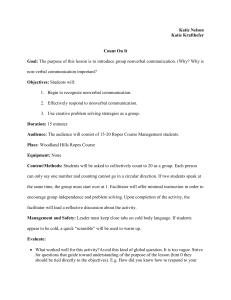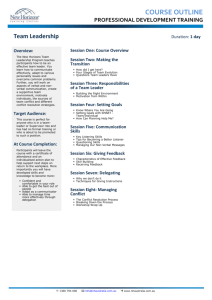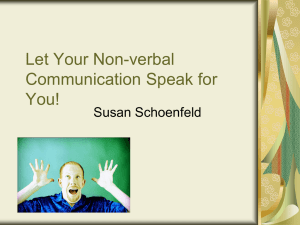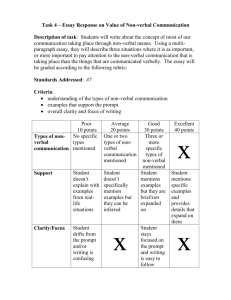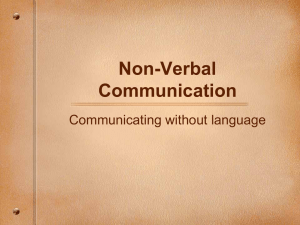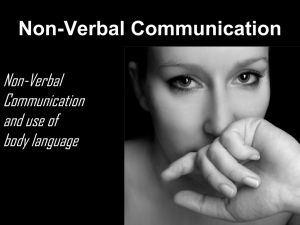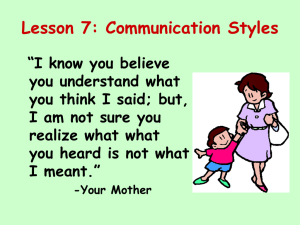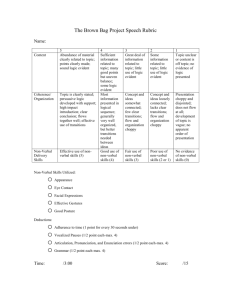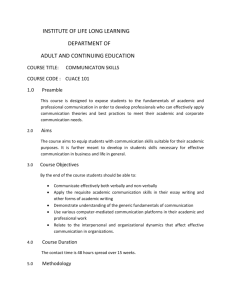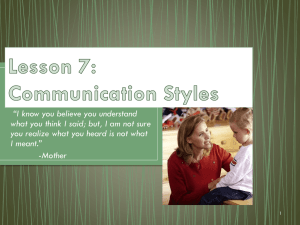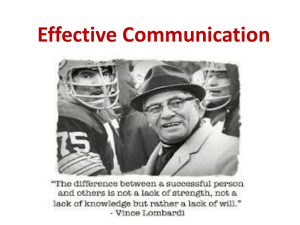NonverbalComm1112 (3)
advertisement
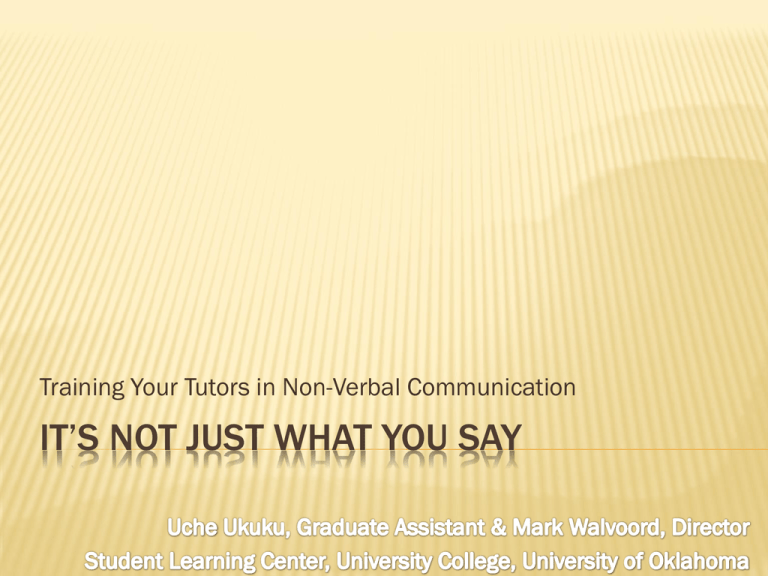
Training Your Tutors in Non-Verbal Communication IT’S NOT JUST WHAT YOU SAY OU’s Student Learning Center Promoting students' critical thinking skills, academic achievement, and positive study habits; especially firstyear students in their transition to OU. free tutoring Encouraging students to take ACTION towards their own academic success Offering academic assistance in over 65 subjects • Multi-location, in-person or online • Drop-in or by-appointment • Staffed by trained, undergrad Peer Learning Assistants, GTAs, and/or Instructors Productive tutor training sessions: • • 8-hour, conference-style at start of semester Weekly opportunities with various topics to get the 4 more required hours per semester OU’s UC Action program is CRLA Level III certified! Avg hours/student Avg # of visits/student 4.61 Spring 2012 4.4 4.62 Fall 2011 4.0 4.62 Spring 2011 4.3 4.66 Fall 2010 4.1 5.17 Spring 2010 4.3 4.58 Fall 2009 4.0 4.80 Spring 2009 3.8 4.17 Fall 2008 3.7 4.03 Spring 2008 Fall 2007 3.3 3.59 2.9 1,985 2,036 2,491 2,500 2,360 UC ACTION VISIT DATA 2,000 Spring 2008 Fall 2008 1,533 1,524 1,658 1,735 Fall 2007 Spring 2009 1,500 Fall 2009 1,087 1,150 Fall 2010 925 942 Spring 2011 Fall 2011 Spring 2012 473 690 691 731 795 793 702 652 608 578 812 866 1,000 1,044 1,000 Spring 2010 0 Visits (in tens) Assistance hours (in tens) Clients Subjects 75 14 24 42 42 47 51 65 65 68 138 170 230 278 500 Training Your Tutors in Non-Verbal Communication IT’S NOT JUST WHAT YOU SAY OVERVIEW Non-verbal communication is described as the process of communication through sending and receiving wordless cues between people. These messages can be communicated through body language, paralanguage, proximity, and silence Most researchers purport that 65-93% of all communication is non-verbal FUNCTIONS Researchers have identified six major functions of nonverbal communication Accenting Complementing e.g., When I want you to stop speaking so I can talk I put one hand out, with the palm facing forward and turn away slightly Repeating e.g., Saying “I’m alright” with tears in my eyes and/or quivering voice Regulating e.g., Biting my fingers while saying I’m nervous Contradicting e.g., A raised eyebrow might accompany an expression of surprise e.g., With car keys in hand, coat and hat on, I can announce: "I'm leaving now," as I walk toward the door. Substituting e.g., A head nod or shake NON-VERBAL COMPONENTS Body Language: nonverbal, usually unconscious, communication through the use of postures, gestures, facial expressions, and the like. Actions come without consent or consciousness, they can indicate aggression, attentiveness, boredom, relaxation, etc. NON-VERBAL COMPONENTS Kroehnert’s (2006) 5 teacher errors in body language 1. nasty personal habits 2. being too stiff 3. blocking or touching the face 4. pointless hand gestures 5. tapping or shaking legs and/or hands NON-VERBAL COMPONENTS CONT. Paralanguage: the communication effect of the speech, pitch, volume, tone, and connectivity of spoken words. Your tone should reinforce the verbal message you are conveying. Vocal intonation is probably the most valid and understood area of non-verbal communication NON-VERBAL COMPONENTS CONT. Silence: absence of any sound or noise Silence can communicate comfort, companionship, or support; it can indicate that he listener cares enough to stay present even if words aren’t being spoken. Silence can motivate students to answer questions. It is also a cue to if/when a student needs help. CAN YOU READ THEIR BODY LANGUAGE? CAN YOU READ THEIR BODY LANGUAGE? CAN YOU READ THEIR BODY LANGUAGE? LIST OF EMOTIONS Shy/Bashful Angry Enthusiastic/Joyful Fearful Bored Frustrated Skeptical Stressed/Anxious Sad STAFF FEEDBACK Feedback from our tutoring staff? Entertaining and meaningful. This session made me think about the cues I want to send my clients It was nice to revisit some concepts of nonverbal communication & how it can apply to tutoring. Learned to recognize body language. Fun activities. It was good to be involved in the discussion. TUTOR TRAINING EVALUATIONS How did The NonVerbal training rank on the evaluations scale of Usefulness as compared to the other sessions offered? (1=least useful – 5= very useful) QUESTIONS??
